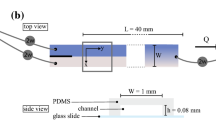Abstract
A simple mathematical method for the analysis of multicomponent displacement development was developed. Calculations in this method utilizes the information residing in the isotactic condition which is established after the full development of solute propagation occurring in the Chromatographie separation operated by the mode of displacement development. Transient shock wave velocities and concentration changes are determined based upon the equilibrium theory of chromatography and the basic rules required in constructing the (t,z)-diagram of solute propagation along the column. Calculations involve solving simple algebraic equations to predict the transient behaviors of propagating solutes inside the column, the elution profiles of final products, and the minimum column length required for the complete separation.
Similar content being viewed by others
References
Aris, R. and Amundson, N. R.,“Mathematical Methods in Chemical Engineering, Vol. 2, First-Order Partial Differential Equations with Applications”, Prentice-Hall, Englewood Cliffs, NJ, 1973.
Claesson, S.,“Theory of Frontal Analysis and Displacement Development”,Discuss. Faraday Soc,7, 34(1949).
DeVault, D.,“The Theory of Chromatography”,J. Am. Chem. Soc,65, 532(1943).
Helfferich, F. and James, D. B.,“An Equilibrium Theory for Rare-earth Separation by Displacement Development”,J. Chromatogr.,46. 1(1970).
Helfferich, F. and Klein, G.,“Multicomponent Chromatography: Theory of Interference”, Marcel Dekker, New York, NY, pp. 52–105, 1970.
Hong, J.,“Optimal Operation Conditions for Displacement Chromatography”, Paper Presented at AIChE Annual Meeting, Washington D.C., November, 1988.
Rhee, H. K., Aris, R. and Amundson, N. A.,“First-Order Partial Differential Equations, Vol. 2, Theory and Applications of Hyperbolic Systems of Quasilinear Equations”, Prentice-Hall, Englewood Cliffs, NJ, pp. 338–359, 1986.
Rhee, H. K., Aris, R. and Amundson, N. R.,“On the Theory of Multicomponent Chromatography”,Phil. Trans. Roy. Soc. London,A267, 419(1970).
Rhee, H. K. and Amundson, N. R.,“Analysis of Multicomponent Separation by Displacement Development”,AIChE J.,28, 423 (1982).
Tiselius, A.,“Displacement Development in Adsorption Analysis”,Arkiv for Kemi, Mineral. Geol.,16A, No. 18, 1 (1943).
Wankat, P. C.,“Rate-Controlled Separations”, Elsevier Science Publ., New York, NY, pp. 239–251, 1990.
Author information
Authors and Affiliations
Rights and permissions
About this article
Cite this article
Lee, K. Development of a mathematical analysis method for the multicomponent separation by displacement development. Korean J. Chem. Eng. 13, 181–186 (1996). https://doi.org/10.1007/BF02705906
Received:
Accepted:
Issue Date:
DOI: https://doi.org/10.1007/BF02705906




